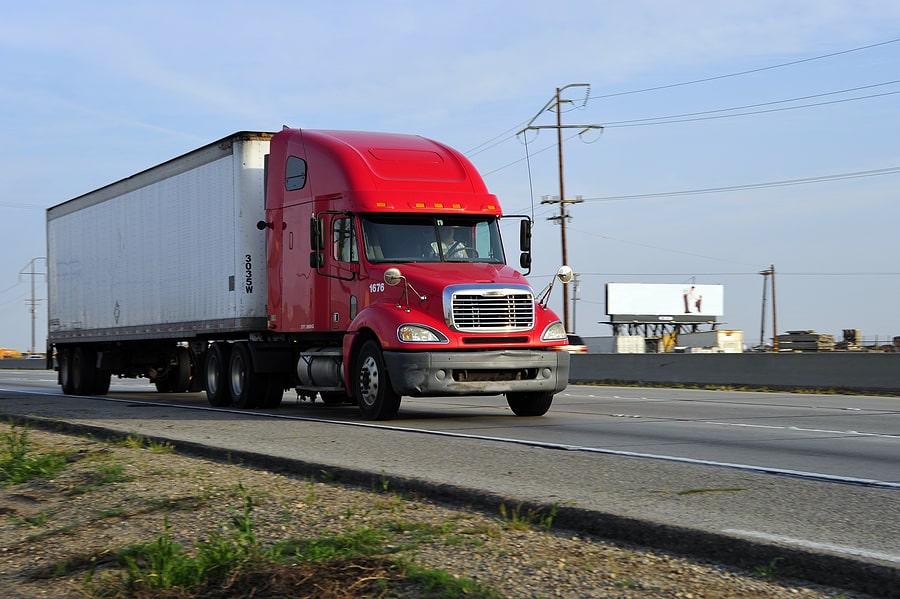Due to the massive difference in size between commercial trucks and most other vehicle types operated on public roadways, truck accidents are often among the most serious types of motor vehicle accidents. It’s nearly impossible to avoid big trucks altogether.
More than 4 million commercial trucks operate in the U.S.. These trucks deliver nearly three-quarters of the products and supplies that people need to conduct their daily lives. With standard dimensions of up to 53 feet long, 8.5 feet wide, and 13.5 feet high, tractor-trailers can weigh up to 80,000 pounds when fully loaded, and this size makes them harder to maneuver and causes other issues that can lead to accidents.
While you cannot control the actions of other drivers to completely avoid accidents, knowing about tractor-trailers can help you avoid accidents in many scenarios.
Here is a look at eight tips for staying safe when sharing the road with commercial trucks.
Know the No Zone

According to Truck Smart, an informational website provided by the Utah Department of Transportation, one of the biggest dangers facing motorists traveling on roadways alongside tractor-trailers is blind spot accidents.
A blind spot is an area on the vehicle that the driver cannot see through the rear or side view mirrors. All vehicles have blind spots, generally around the rear sides of the vehicle in passenger cars. In commercial trucks, however, significant blind spots appear on every side of the vehicle. The blind spots on a truck are its no zones.
To be clear, it is the truck driver’s responsibility to ensure that a lane is clear before merging or changing to that lane.
However, drivers of other vehicles can help avoid this type of accident by being aware of the no zones and avoiding traveling in these areas.
- The truck’s front no zone extends 20 feet ahead of the front bumper. Drivers who cut off tractor-trailers in traffic place themselves in an extremely dangerous situation where the truck driver might not be aware that they’ve entered the lane and will therefore be less equipped to come to a stop or slow down to avoid rear-ending the car.
- The truck’s side no zones are also significant, extending one travel lane on the driver’s side along the length of the cab and two travel lanes on the passenger side for the entire length of the vehicle.
- The truck’s rear no zone extends nearly 200 feet behind the truck. Commercial trucks do not have rearview mirrors, and truck drivers must rely on their side view mirrors to see what is happening behind them. Pedestrians should avoid walking behind tractor-trailers, and other drivers on the road need to use caution when traveling too closely behind tractor-trailers because not only is it very likely that the truck driver does not realize there is a car riding their bumper, but the driver of the car is unable to see what is on the roadway ahead of the truck and can be unprepared if the driver suddenly stops or slows.
Pro tip: If you want to know if you’re in the truck driver’s blind spot, look for their face. Can you see their face in their side view mirror? If you can’t, the driver likely can’t see you either. Avoid lingering in the blind spot.
Beware of the Squeeze Play
The truck’s size makes it difficult to navigate around corners, requiring the driver to swing the vehicle out into other travel lanes to complete tight turns when maneuvering through intersections on busy city roadways.
A squeeze play starts with a commercial truck turning right. The truck driver swings the vehicle to the left to complete the wide right turn, and the driver in the vehicle—believing the truck is changing lanes—will attempt to dart past it on the right side. The car is now caught in the driver’s passenger-side blind spot and trapped between the curb and the truck.
The Federal Motor Carrier Safety Administration (FMCSA), which is the federal organization tasked with regulating the trucking industry, warns drivers to avoid wide turn accidents by giving the truck enough space to determine what their intentions are and to wait until the truck has completed its turn before continuing on their journey. Further, drivers are warned to avoid passing tractor-trailers on the right, which places them in the truck’s largest no zone.
The Long Game of Stopping a Truck
For any type of motor vehicle, braking is a process. The process begins when the vehicle’s driver perceives a hazard on the roadway and responds to that hazard by depressing the brakes.
The brakes pull the vehicle’s weight to a safe stop. As noted by the Insurance Institute for Highway Safety (IIHS), commercial trucks require 20 to 40 percent more distance to stop, and the stopping distance can increase with a truck traveling at a higher speed, on wet or icy roads, or the on worn tires. The FMCSA notes that a truck may need two football fields worth of space to stop.
If other drivers know the long stopping distance of a tractor-trailer, they may use extra caution when merging into a lane in front of the truck.
The Long Game of Getting the Truck Back Up to Speed, and the Dangers of Speeding Trucks
Just as tractor-trailers require a longer distance for the vehicle’s brakes to pull its weight to a complete stop, the vehicle’s weight also causes it to take longer for the truck to get back up to speed after stopping at a light.
These slow starts can cause impatience for other drivers, with drivers often attempting to quickly maneuver around the truck in or just past the intersection so they can get ahead of it. Drivers are urged to be patient with trucks as they accelerate and remember that even when a truck travels slowly, it still has blind spots. Don’t tailgate, and don’t attempt to pass on the right.
The same holds true when trucks are traveling up hills. The vehicle’s weight will cause it to slow down while climbing hills and create impatience for other drivers, which can lead to aggressive driving tactics.
As a vehicle increases its speed, the danger of an accident also increases. The driver has less time to perceive road hazards and respond to them by braking. The severity of crashes that do occur is increased by the additional force created by excessive speed.
Additionally, the truck’s stopping distance is also larger due to speed. Because of these hazards, many truck driving companies have limited the speed at which their drivers are legally allowed to travel.
According to the trucking trade publication Freight Waves, the FMCSA has announced that it will also address allowable speeds for the trucking industry. The agency proposes a rule requiring large commercial trucks to be equipped with electronic engine control units (ECUs) to govern the maximum speed at which the truck is allowed to travel.
The proposal comes in response to the growing number of accidents involving commercial trucks in which speed is listed as a contributing factor, which the FMCSA noted was unacceptable. However, the trucking industry has mixed feelings about mandating speed limiters, with some believing that it will lead to an increase in accidents due to the speed limiter creating a higher variance in the speeds of vehicles traveling on the road.
Understand Where Trucks Drive
As explained by DefensiveDriving.org, when traveling on interstates or other busy roadways, truck drivers tend to prefer traveling in the middle lanes. This helps them stay out of the way of drivers in the fast lane and those attempting to enter or exit the roadway in the right-hand lane. Drivers who do not want to travel behind the truck should travel in the left or right lane.
Watch Out for Drifting Trucks
A truck drifting in and out of a travel lane can be a potential indication of several things, each of which can pose hazards for other drivers. The truck driver could be fatigued or impaired.
The wind could blow, making it difficult for the driver to maneuver a truck, particularly after they have delivered a load and their trailer is empty. The truck could have mechanical issues, such as the axles under the trailer being out of alignment. Whatever the cause, drivers attempting to navigate their vehicles around drifting trucks should use extra caution.
It is important to remember that large trucks often create wind currents that can be felt by other drivers attempting to pass. Extra attention and care are needed to maintain control of your travel lane.
Always Give the Truck the Right-of-Way
Determining who has the right-of-way can be difficult for any type of driver. If you’re at an intersection and you’re not sure whether you have the right-of-way or the truck driver does, you should always let the truck go first, with the understanding that the truck has less capability to stop and its driver has less ability to see you. Even if you feel like you should have gone first, avoiding an accident with the truck is more important.
Cultivate Your Own Good Driving Habits

To repeat: good driving habits won’t make everyone else drive safely, even truck drivers. But it can help you be prepared and better able to respond to the bad habits of other drivers and can help in many circumstances to avoid making a dangerous situation involving the maneuverability issues of a truck even worse.
Some of the safe driving techniques to use to avoid truck accidents include:
- Reduce distractions, such as texting and other cell phone use, visiting with passengers, or daydreaming while in the car. This helps you be more mindful of whether you’re traveling in a truck’s blind spot or too close to any vehicle. Remember that trucks do not have rearview mirrors, and the driver can’t see you if you are within 200 feet of the back of their vehicle.
- Drive slow and steady when traveling near commercial trucks, and use care when pulling in front of them. Emergency maneuvers are more difficult to do safely in a truck and can lead to the truck rolling over.
- Avoid driving when tired. If you’ve ever taken a long road trip, you likely noticed that the later at night it is, you will see more trucks. Truck drivers often drive at night due to less traffic, less construction, and fewer distractions. Unfortunately, most humans instinctively sleep at night. While long-haul truck drivers are most commonly associated with fatigued driving, anyone driving late at night can suffer from fatigue, which causes slowed responses, difficulty maintaining a single lane of travel, and difficulty maintaining speed—all of which are dangerous, particularly when traveling on a roadway filled with commercial trucks.
Contact a personal injury lawyer for a free case evaluation if you were injured or lost a loved one in a truck accident.